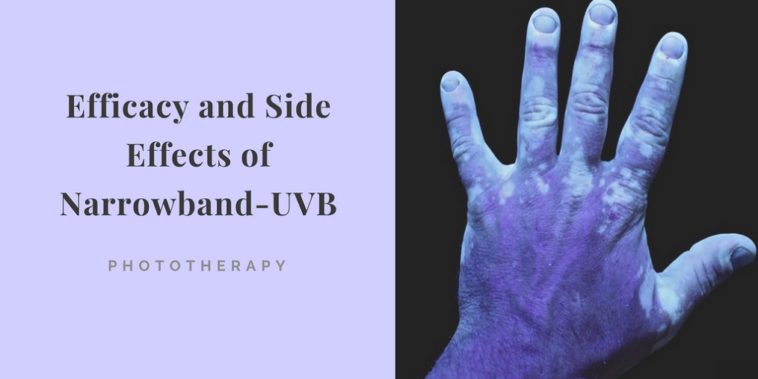The most common sub type of vitiligo, nonsegmental vitiligo, occurs in 85 to 90% of cases. While the exact cause of nonsegmental vitiligo is unknown, it is believed to have an autoimmune component. This means that the body’s own immune system attacks and destroys the melanocytes, causing the loss of pigment and leading to white patches seen in the disorder. There is no known cure for nonsegmental vitiligo. However, several treatments have been shown to reduce the spread of the lesions and to initiate repigmentation of the skin. Narrowband UVB Phototherapy is one of them.
Narrowband UVB phototherapy is a potent melanocytes stimulant and currently seen as the phototherapy of choice for vitiligo. It is a medical procedure, which involves exposing vitiligo lesions to fluorescent lamps which emit the ultraviolet light of a range of wavelengths between 310 and 315 nanometers.
Hoe does Narrowband UVB Phototherapy work in vitiligo
Mechanism to stop the progression
Narrowband UVB phototherapy attempts to stop the progression of vitiligo by suppressing the immune system in the region to which it is applied. Since it is the immune system which destroys the pigment-producing melanocytes, narrowband UVB stabilizes the abnormal immune response by causing the death of the cells involved in the immune response and by triggering the release of chemicals which suppress the immune system and impair its aggression.
Mechanism to initiate repigmentation
Importantly, narrowband UVB therapy also assists in restoring pigment to the vitiligo lesions. For repigmentation to occur, functioning melanocytes must be present in the skin. Narrowband UVB therapy can stimulate functional melanocytes found in the hair.
To understand this Narrowband UVB’s mechanism, you need to understand where melanocytes are found. Melanocytes are located in the top layer of our skin (the epidermis) as well as the hair follicles (which is placed in the deeper layers of the skin). Because, the hair follicles possess a special area known as the niche where the melanocytes stem cells or immature melanocytes are located and maintained in a specific environment, these cells can be preserved from the factors that destroy skin melanocytes in vitiligo.
When stimulated by narrowband UVB, the stem cells in the hair follicle migrate to the epidermis for becoming melanocytes – melanin-producing neural crest-derived cells. In turn, the melanin forms islands of pigmentation in the two millimeters or so, surrounding the hair. Over time, the melanocytes migrate further continuing to produce melanin, and these islands of pigmentation spread to cover the entire lesion.
Narrowband UVB therapy also stimulates viable melanocytes within the depigmented area, which may have survived the attack of the immune system. Furthermore, narrowband UVB stimulates functioning melanocytes at the edges of the lesions peripherally to migrate into the affected area and aid in repigmentation.
Prognosis of Narrowband UVB Phototherapy
Narrowband UVB phototherapy is considered an ideal treatment for vitiligo covering more than 20% of the body. The degree of repigmentation achieved depends on the type of vitiligo, the area of the body affected, and the duration of the skin disorder.
Since phototherapy is often conducted in a healthcare facility, it becomes an expensive therapy. Some medications (along with the therapy) can be prescribed to achieve the best results. Depending on the depigmented area of the skin, therapy sessions are decided.
Candidates for Narrowband UVB phototherapy should be carefully screened and educated. Various aspects of this therapy such as the cost, treatment time, probable permanency, side effects, and the possibility of recurring depigmentation should first be discussed first. An individual must be provided enough time and assistance in making the decision. Family members should also be involved in the process. The therapy is often avoided in children less than 12 years of age.
Reported side effects
Although narrowband UVB is the only available alternative for nonsegmental vitiligo, the drawbacks are numerous. Acute side effects that have been reported are dryness itchiness and redness. However, these are generally resolved after the application of topical emollients.
Chronic side effects of narrowband UVB may include skin aging and photocarcinogenesis, which may lead to skin cancer. Though these long-term effects are yet to be fully investigated, treatment by narrowband UVB is required three times a week, for up to 18 months.

